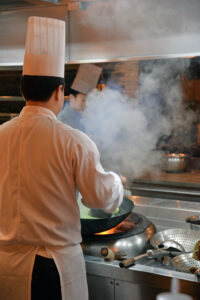If you’re in the market for new cookware and happen to have a gas stove, you might be wondering what type of cookware is best for your specific cooking setup. With so many options available, it can be overwhelming to determine which cookware will truly enhance your culinary experience. From the safest materials to the most durable construction, finding the perfect cookware for your gas stove requires a little research and consideration. In this article, we’ll explore the various factors to consider when choosing cookware for a gas stove, including heat conduction, material compatibility, and overall performance. By the end, you’ll be equipped with the knowledge you need to make an informed decision and upgrade your cooking arsenal with confidence.

This image is property of images.pexels.com.
Factors to Consider
When choosing cookware for your gas stove, there are several important factors to consider. These factors will help you determine the best material and type of cookware that suits your needs and enhances your cooking experience. Here are the key factors to consider:
Heat Conductivity
One of the most crucial factors to consider when selecting cookware for a gas stove is heat conductivity. Gas stoves provide instant and precise heat control, so it is important to choose cookware that can distribute heat evenly and efficiently. Cookware with excellent heat conductivity will ensure that your food cooks evenly and prevents hot spots.
Material Compatibility
Another important factor to consider is the material compatibility of the cookware. Gas stoves generate high heat, so it is essential to select cookware that can withstand the intense heat without warping or damaging the surface. Different cookware materials have different heat resistance levels, so choose a material that is compatible with your gas stove’s heat output.
Durability
Durability is crucial when investing in cookware for a gas stove. You want your cookware to last for years of cooking adventures without deteriorating or losing its performance. Look for cookware made from sturdy materials that can withstand the rigors of gas stove cooking and won’t easily chip, scratch, or dent.
Maintenance and Care
Consider the maintenance and care required for the cookware you choose. Some materials may require special cleaning or seasoning methods, while others may be dishwasher-safe. Determine the amount of effort you are willing to put into caring for your cookware and choose a material that aligns with your preferences and lifestyle.
Price Range
Lastly, consider your budget when selecting cookware for your gas stove. Cookware comes in a wide range of prices, so it’s important to find a balance between quality and affordability. Remember that investing in higher-quality cookware can often save you money in the long run, as these pieces tend to last longer and perform better.
Materials for Gas Stove Cookware
There are several materials commonly used in gas stove cookware. Each material has its own characteristics, advantages, and disadvantages. Understanding the properties of each material will help you make an informed decision when selecting your cookware. Here are the primary materials used in gas stove cookware:
Stainless Steel
Stainless steel is a popular choice for gas stove cookware due to its durability and versatility. It is highly resistant to corrosion, staining, and rust, making it a long-lasting option. Stainless steel also has good heat conductivity, allowing for even heat distribution. Additionally, it is non-reactive, which means it won’t leach any metallic flavors or react with acidic foods. However, stainless steel may not be the best choice if you are looking for cookware with excellent heat retention.
Cast Iron
Cast iron cookware is beloved for its exceptional heat retention and even heat distribution. It is ideal for achieving a perfect sear on steaks and creating deep, rich flavors in stews and casseroles. Cast iron also develops a natural non-stick coating over time, making it suitable for cooking a wide range of dishes. However, cast iron cookware requires proper care and seasoning to prevent rust, and it is quite heavy compared to other materials.
Carbon Steel
Similar to cast iron, carbon steel cookware offers excellent heat retention and even heat distribution. It is lightweight, making it easier to handle than cast iron, and can be used on both gas stoves and induction cooktops. Carbon steel cookware requires seasoning to develop its non-stick properties and prevent rust. It is commonly used for woks, frying pans, and paella pans.
Aluminum
Aluminum cookware is lightweight and offers quick and even heat distribution, making it popular for gas stove cooking. It heats up rapidly, which is advantageous for tasks like boiling water or searing meats. However, aluminum is a reactive material, so it may interact with acidic ingredients and alter the taste of your food. To combat this, many aluminum cookware pieces are now coated with non-stick materials or anodized to create a protective layer.
Copper
Copper cookware provides exceptional heat conductivity, allowing for precise control over cooking temperatures. It heats up quickly and promotes uniform heat distribution, making it ideal for gas stoves. Copper cookware is also aesthetically pleasing and adds an elegant touch to your kitchen. However, copper requires regular polishing to maintain its lustrous appearance, and it is typically more expensive than other materials.
Non-Stick
Non-stick cookware has a coating that prevents food from sticking, making it easier to cook and clean up. It is commonly made with aluminum or stainless steel as the base material. Non-stick cookware is ideal for delicate foods like pancakes or eggs, as it requires less oil and ensures easy release. However, it is important to use non-metal utensils to avoid scratching the non-stick coating, and there is some debate over the safety of certain types of non-stick coatings.
Enamel-Coated
Enamel-coated cookware is made by coating a base material (often cast iron or stainless steel) with enamel. The enamel coating provides a smooth surface that is resistant to sticking and staining. Enamel-coated cookware is easy to clean and comes in a variety of colors to complement your kitchen decor. However, enamel can chip or crack with rough handling, and it may not be suitable for high-heat cooking or broiling.
Stainless Steel Cookware
Pros
Stainless steel cookware offers several advantages for gas stove cooking. Its durability ensures that it will withstand high heat without warping or showing signs of wear. Stainless steel is also non-reactive, making it suitable for cooking acidic foods without altering their taste. It is relatively easy to clean, and many Stainless steel cookware sets are dishwasher-safe. Additionally, stainless steel cookware provides a sleek and modern look that complements any kitchen.
Cons
Despite its numerous advantages, stainless steel cookware does have a few drawbacks. It is not the best material for heat retention, as stainless steel tends to heat up quickly but also cool down rapidly. To overcome this, many stainless steel cookware sets come with a multi-layered base that includes aluminum or copper for improved heat conductivity. Stainless steel can also be prone to food sticking, especially when cooking eggs or delicate fish. Using proper cooking techniques like preheating the pan and using sufficient oil can help mitigate this issue.
Recommended Brands
When selecting stainless steel cookware for your gas stove, it is important to choose reputable brands known for their quality and performance. Some recommended brands to consider include All-Clad, Calphalon, Cuisinart, and Tramontina. These brands offer a range of stainless steel cookware sets with various features and price points to suit different needs and budgets.
Cast Iron Cookware
Pros
Cast iron cookware is highly regarded for its exceptional heat retention and even heat distribution. It holds and distributes heat evenly, allowing for precise and consistent cooking results. Cast iron is ideal for searing meats, creating deep flavors in stews and soups, and even baking bread. The natural non-stick properties that develop over time make cast iron cookware easy to use and clean.
Cons
While cast iron cookware offers many benefits, it does come with a few downsides. The weight of cast iron can be a challenge for some, as it is significantly heavier than other materials. This weight also means it takes longer to heat up and cool down. Cast iron requires regular seasoning and proper care to prevent rust and maintain its non-stick surface. It is also not suitable for cooking highly acidic foods or delicate dishes that require precise temperature control.
Recommended Brands
When it comes to cast iron cookware, Lodge is one of the most reputable and reliable brands. Their cast iron pans and Dutch ovens are known for their quality craftsmanship and excellent performance. Other recommended brands include Le Creuset, Staub, and Victoria, which offer a variety of cast iron cookware pieces that are built to last.

This image is property of images.pexels.com.
Carbon Steel Cookware
Pros
Carbon steel cookware shares many similarities with cast iron, but it is lighter and more responsive to changes in heat. It offers excellent heat retention and distribution, ensuring even cooking results. Carbon steel pans also develop a natural non-stick coating over time, making them ideal for various cooking tasks. They are highly versatile and can be used for frying, sautéing, braising, and more.
Cons
One of the main drawbacks of carbon steel cookware is its need for proper care and seasoning. Like cast iron, carbon steel requires regular seasoning to maintain its non-stick properties and prevent rust. It may also react with acidic ingredients, altering the taste of certain dishes. Additionally, carbon steel pans can be prone to warping if subjected to extreme temperature changes.
Recommended Brands
Matfer Bourgeat and Made In are two highly regarded brands when it comes to carbon steel cookware. Both offer a range of high-quality carbon steel pans and skillets that are built to withstand the demands of gas stove cooking. These brands prioritize excellent heat conductivity and durability, ensuring that your carbon steel cookware will last for years to come.
Aluminum Cookware
Pros
Aluminum cookware is lightweight and offers excellent heat conductivity, making it a popular choice for gas stove cooking. It heats up quickly and evenly, allowing for precise temperature control and efficient cooking. Aluminum pans are also relatively affordable compared to other materials, making them a budget-friendly option. Many aluminum cookware pieces are now coated with non-stick materials or anodized to create a protective layer, making them even more versatile and convenient.
Cons
The main drawback of aluminum cookware is its reactivity with acidic ingredients. When cooking highly acidic foods, such as tomatoes or citrus fruits, the aluminum may leach into the food and alter its taste. To minimize this risk, opt for hard-anodized aluminum cookware or look for aluminum cookware with non-reactive coatings. Another consideration is that aluminum is a soft material, so it is prone to scratches and dents.
Recommended Brands
When selecting aluminum cookware for your gas stove, brands like Calphalon, T-fal, and Cooks Standard offer a wide range of options to choose from. These brands prioritize quality craftsmanship, reliable performance, and affordability, making them popular choices among home cooks and professional chefs alike.

This image is property of images.pexels.com.
Copper Cookware
Pros
Copper cookware provides exceptional heat conductivity, making it a favorite among professional chefs. It heats up quickly and allows for precise temperature control, ensuring even cooking results. Copper pans are also highly responsive to heat adjustments, making them ideal for delicate tasks like sautéing or simmering. Furthermore, copper cookware adds a touch of elegance to your kitchen with its beautiful, shiny appearance.
Cons
The main drawback of copper cookware is its high price tag. Copper is an expensive material, making copper cookware sets quite an investment. Additionally, copper requires regular polishing to maintain its appearance and prevent tarnishing. It is also a reactive material, so it may interact with acidic foods, resulting in a metallic taste. To combat this, most copper cookware is lined with stainless steel or tin to create a safe and non-reactive cooking surface.
Recommended Brands
If you’re considering investing in copper cookware, brands like Mauviel, Falk Culinair, and Hestan offer exceptional quality, craftsmanship, and performance. They use high-quality materials and innovative techniques to create exquisite copper cookware that delivers superior cooking results and withstands the rigors of gas stove cooking.
Non-Stick Cookware
Pros
Non-stick cookware has a coating that prevents food from sticking, making it extremely convenient and easy to use. It requires less oil for cooking and is a great option for those looking to reduce their fat intake. Non-stick pans are ideal for cooking delicate foods like eggs, pancakes, and fish, as they ensure easy release and quick cleanup. Many non-stick cookware pieces are also dishwasher-safe, making them even more convenient for everyday use.
Cons
One of the main concerns with non-stick cookware is the safety of the coatings used. Traditional non-stick coatings, such as Teflon, may release toxic fumes when exposed to high heat. To address this, many manufacturers now offer PFOA-free and PTFE-free non-stick coatings that are considered safer alternatives. However, even with safer coatings, it is important to use non-stick cookware responsibly and avoid overheating. Another drawback is that non-stick coatings can wear off over time, requiring the replacement of the cookware.
Recommended Brands
When it comes to non-stick cookware, brands like T-fal, Calphalon, and GreenPan are highly regarded for their quality and reliability. These brands offer a wide range of non-stick cookware options with different features, such as ceramic or diamond-infused coatings, to suit various cooking needs and preferences. It’s important to choose non-stick cookware from reputable brands to ensure the safety and longevity of the coating.
Enamel-Coated Cookware
Pros
Enamel-coated cookware offers a smooth and non-stick cooking surface that is resistant to staining and sticking. It is easy to clean and comes in a variety of vibrant colors, adding a pop of personality to your kitchen. Enamel-coated cookware is highly versatile and can be used for a wide range of cooking tasks, from simmering soups to baking casseroles. It is also dishwasher-safe, making cleanup a breeze.
Cons
One of the main cons of enamel-coated cookware is its tendency to chip or crack with rough handling or extreme temperature changes. It is important to handle enamel-coated cookware with care and avoid using metal utensils that may scratch the surface. Another consideration is that enamel-coated cookware may not be suitable for high-heat cooking or broiling, as excessive heat can damage the enamel coating.
Recommended Brands
When selecting enamel-coated cookware, brands like Le Creuset, Staub, and Lodge are known for their high-quality and durable products. These brands offer a wide range of enamel-coated cookware pieces in various sizes and colors to suit different cooking needs and style preferences. Their cookware is built to last and delivers excellent heat distribution and retention, ensuring delicious and consistent cooking results.
Other Considerations
Cookware Set or Individual Pieces
Before making a decision, consider whether you prefer purchasing a cookware set or individual pieces. Cookware sets typically offer a range of essential pieces that can cover most cooking needs, while individual pieces allow for more flexibility in building your collection according to your specific requirements and preferences.
Handles and Lids
Evaluate the handles and lids of the cookware you are considering. Comfortable and secure handles are essential for easy and safe handling, especially when transferring hot pots and pans. Additionally, well-fitted lids help to retain heat and moisture during cooking, enhancing the quality of your dishes.
Oven-Safe
If you plan on using your cookware in the oven, ensure that it is oven-safe. This information can usually be found on the product packaging or in the product description. Oven-safe cookware provides versatility and allows you to seamlessly transition from stovetop to oven for certain recipes.
Dishwasher-Safe
Consider whether dishwasher-safe cookware is important to you. Some cookware materials and coatings may require handwashing or specific care instructions. If you prefer the convenience of using a dishwasher, look for cookware that is labeled as dishwasher-safe.
Manufacturer Recommendations
Always follow the manufacturer’s recommendations for care, use, and maintenance of your cookware. Each brand may have specific instructions to ensure the longevity and performance of their products. It is important to familiarize yourself with these recommendations to avoid any unnecessary damage or accidents.
Consumer Reviews
Finally, take the time to read consumer reviews and ratings before purchasing cookware. Real-life experiences from other users can provide valuable insights into the performance, durability, and overall satisfaction with a particular brand or product. Look for cookware with positive reviews and reliable customer feedback.
By considering these factors and taking the time to research and understand the different materials and types of cookware available, you can make an informed decision that will enhance your cooking experience on your gas stove. Remember to prioritize your specific needs and preferences to find the best cookware set or individual pieces that suit you. Happy cooking!

